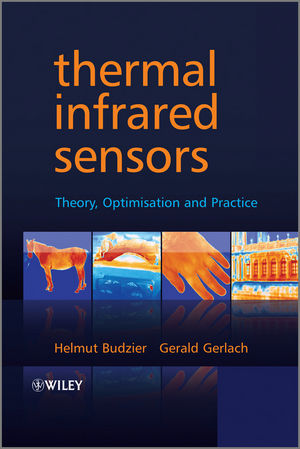Thermal Infrared Sensors: Theory, Optimisation and PracticeISBN: 978-0-470-87192-8
Hardcover
328 pages
February 2011
 |
||||||
List of Examples.
List of Symbols.
Indices.
Abbreviations.
1 Introduction.
1.1 Infrared Radiation.
1.1.1 Technical Applications.
1.1.2 Classification of Infrared Radiation.
1.2 Historical Development.
1.3 Advantages of Infrared Measuring Technology.
1.4 Comparison of Thermal and Photonic Infrared Sensors.
1.5 Temperature and Spatial Resolution of Infrared Sensors.
1.6 Single-Element Sensors Versus Array Sensors.
References.
2 Radiometric Basics.
2.1 Effect of Electromagnetic Radiation on Solid-State Bodies.
2.1.1 Propagation of Radiation.
2.1.2 Propagation in Lossy Media.
2.1.3 Fields at Interfaces.
2.1.4 Transmission Through Thin Dielectric Layers.
2.2 Radiation Variables.-
2.2.1 Radiation-Field-Related Variables.
2.2.2 Emitter-Side Variables.
2.2.3 Receiver-Related Variables.
2.2.4 Spectral Variables.
2.2.5 Absorption, Reflection and Transmission.
2.2.6 Emissivity.
2.3 Radiation Laws.
References.
3 Photometric Basics.
3.1 Solid Angle.
3.1.1 Definition.
3.1.2 Solid Angle Calculations.
3.2 Basic Law of Photometry.
3.2.1 Definition.
3.2.2 Calculation Methods and Examples.
3.2.3 Numerical Solution of the Projected Solid Angle.
References.
4 Noise.
4.1 Mathematical Basics.
4.1.1 Introduction.
4.1.2 Time Functions.
4.1.3 Probability Functions.
4.1.4 Correlation Functions.
4.1.5 Spectral Functions.
4.1.6 Noise Analysis of Electronic Circuits.
4.2 Noise Source in Thermal Infrared Sensors.
4.2.1 Thermal Noise and tan δ.
4.2.2 Current Noise.
4.2.3 1/f Noise.
4.2.4 Radiation Noise.
4.2.5 Temperature Fluctuation Noise.
References.
5 Sensor Parameters.
5.1 Responsivity.
5.1.1 Introduction.
5.1.2 Black Responsivity.
5.1.3 Spectral Responsivity.
5.1.4 Signal Transfer Function.
5.1.5 Uniformity.
5.2 Noise-Equivalent Power NEP.
5.3 Detectivity.
5.4 Noise-Equivalent Temperature Difference.
5.5 Optical Parameters.
5.6 Modulation Transfer Function.
5.6.1 Definition.
5.6.2 Contrast.
5.6.3 Modulation Transfer Function of a Sensor.
5.6.4 Measuring the Modulation Transfer Function.
References.
6 Thermal Infrared Sensors.
6.1 Operating Principles.
6.2 Thermal Models.
6.2.1 Simple Thermal Model.
6.2.2 Thermal Layer Model.
6.3 Network Models for Thermal Sensors.
6.4 Thermoelectric Radiation Sensors.
6.4.1 Principle.
6.4.2 Thermal Resolution.
6.4.3 Design of Thermoelectric Sensors.
6.5 Pyroelectric Sensors.
6.5.1 Principle.
6.5.2 Thermal Resolution.
6.5.3 Design of Pyroelectric Sensors.
6.6 Microbolometers.
6.6.1 Principle.
6.6.2 Thermal Resolution.
6.6.3 Design of a Microbolometer Array.
6.6.4 Read-Out Electronics of Microbolometers.
6.7 Other Thermal Infrared Sensors.
6.7.1 Bimorphous Infrared Sensors.
6.7.2 Micro-GOLAY Cells.
6.8 Comparison of Thermal Sensors.
References.
7 Applications of Thermal Infrared Sensors.
7.1 General Considerations.
7.2 Pyrometry.
7.2.1 Design.
7.2.2 Emissivity of Real Emitters.
7.3 Thermal Imaging Cameras.
7.3.1 Design.
7.3.2 Calibration of Thermal Imaging Cameras.
7.4 Passive Infrared Motion Detector.
7.4.1 Design.
7.4.2 Infrared Optics.
7.4.3 Signal Processing.
7.5 Infrared Spectrometry.
7.5.1 Radiation Absorption of Gases.
7.5.2 Design of an Infrared Spectrometer.
7.6 Gas Analysis.
References.
Appendix A: Constants.
Appendix B: PLANCK?s Law of Radiation and Derived Laws.
Appendix C: Calculation of the Solid Angle of a Rectangular Area.
Further Reading and Sources.
Index.



